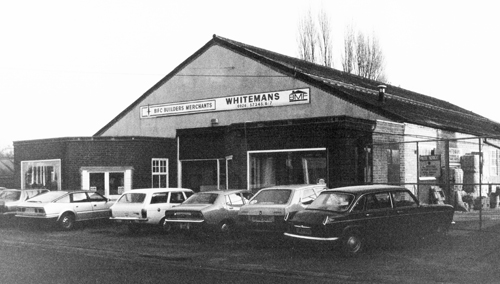Station Development brings demolition of historic building
(Published KWN May 2015)

The former garage as Walter Whiteman’s builder’s merchants in the 1980s
The preparations for the construction of Kenilworth’s new railway station has seen the site recently cleared of all structures; this includes the main builder’s merchants building that had an 85-year story far more fascinating than may be expected.
In the Edwardian years, the site was earmarked for the town’s new post office, convenient for the station, but that was eventually built in the town centre. The site was subsequently bought in the late 1920s by a man named Alfred Wray who constructed the building as a garage, set back from the road to include a small forecourt with petrol pumps. Wray specialised in sports cars and high grade cars, Bugattis and Bentley’s in particular, and large doors behind the pumps allowed access to the building. As business increased, the building was extended lengthways several times; one feature of it being its shape – it tapered, the railway end being almost 4 feet wider than the road end.
At the start of the war, Wray moved in engineering machinery for small part repetition work; parts for ammunition and Bailey Bridge floats being known produce. With a forecourt no longer needed, offices were added to the front of the building. After the war, Wray made petrol tanks for Armstrong Siddeley.
In 1955 it was taken over by the Ministry of Supply for the benefit of George Rawlings & Partners for the “Construction of scale research models for supersonic research”. Rawlings had moved from the buildings that are today Millar Court. Rawlings built high quality models for testing in wind-tunnels and they included the wings of the famous TSR2, and a calibration model for the development of Concorde. Rawlings stayed until 1975.
The next part of the story starts back in the 1890’s with Burnham Brothers Coal Merchants based at the station. In 1930, Station master Ernest Whiteman bought out Burnham’s for his son Walter to take over; Whitemans became the town’s leading coal merchant. At the end of the war, Walter Whiteman became the agent for Ketton cement, selling their wares in the station yard, and this soon became his fully fledged builders merchants based across Priory Road in the buildings soon to be demolished to make way for flats. With the closure of the station in 1965, Walter Whiteman took over the former goods yard as a new base for his merchants business and in 1975 when Rawlings moved out also took over the large adjacent building.
The building was to remain a builder’s merchants through several changes of ownership until demolition 40 years later just a few weeks ago.
To the end, behind the modern roof panels was lifting equipment from its days as an engineering base, and some of the roof windows carried black paint, believed to be a survivor of wartime blackout restrictions.
Footnote: Although I have information from two sources that appear to confirm the building was tapered, visual inspection, for example of the wall corners and roof structure, failed to reveal this.
Additional photos:
These were taken on 27th January 2015, shortly before demolition. It has been suggested that the blackened roof windows were a leftover from wartime blackout paint. The mezzanine floor was added during the time of George Rawlings & Partners.


More Railway articles on this website:
Kenilworth’s Railway, a brief history of its early years Kenilworth’s First railway station
Kenilworth’s Second Station Kenilworth Second Station Demolished Kenilworth’s Third Station
The Railway by Maps Railway Bridges and Crossings Railway Protestations – 1840 & 2010
Iconic Station Photograph Investigated The end for Historic Bridges? Railway gallery